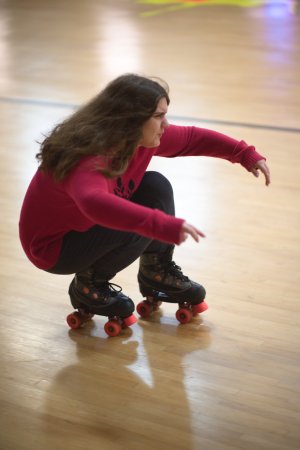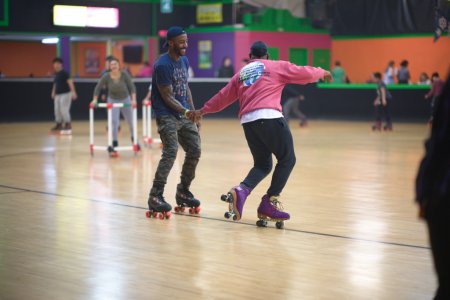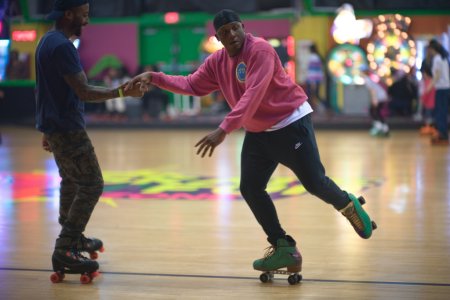GMOG
Established
Similar to what Greg did, I bought a Z6 to use exclusively with my 1950's Nikkor S lenses.
Most of the lenses I'm using on the Z5 are Leitz 50s and 35s in M and adapted LTM mounts. The S mount Nikkor-S 50/1.4 is something new to try, and I'm liking it so far. I still need to buy a F to Z adapter for all the pre-AI Nikkors I have and love.
Godfrey
somewhat colored
Hmm. I've done this "using adapted lenses" thing over the years with Leica M and R lenses on Sony A7, Olympus EM-1, and other 'mirrorless' bodies. I do it now with Leica R lenses on my M10M, M10R bodies and with Leica M and R lenses on my Hasselblad 907x/CFVII 50c, with about the same results. It just takes a little while to figure which configuration works best, with each different camera, but they all end up very nearly the same. 
G
G
Most of the lenses I'm using on the Z5 are Leitz 50s and 35s in M and adapted LTM mounts. The S mount Nikkor-S 50/1.4 is something new to try, and I'm liking it so far. I still need to buy a F to Z adapter for all the pre-AI Nikkors I have and love.
I have such an adapter that I no longer need. PM me your address if you want it.
GMOG
Established
I have such an adapter that I no longer need. PM me your address if you want it.
Sent!
Timmyjoe
Mentor
What I liked about the Nikkor-S lenses on the Z6 is how small they are and how close to the camera they sit. That is the one thing that I don't like about the Z series cameras, whenever I mount one of my large collection of Nikkor F lenses, they are very front heavy, as they have to sit so far out in front of the focal plane to focus properly.
I wish Voigtlander would make more Nikon Z manual focus lenses, if they did, I could see getting a Zf camera body. As for now, I use a Nikon Zfc with Olympus Pen-F lenses. It's a great, compact shooting system, but the old Pen-F lenses aren't quite of the optical quality I would like.
Best,
-Tim
I wish Voigtlander would make more Nikon Z manual focus lenses, if they did, I could see getting a Zf camera body. As for now, I use a Nikon Zfc with Olympus Pen-F lenses. It's a great, compact shooting system, but the old Pen-F lenses aren't quite of the optical quality I would like.
Best,
-Tim
MarkWalberg
Established
Interesting. How does this work? What do you see when using it?Zf can track the focus point for manual lenses, there's a setting to enable that. I have played around with it and it works reasonably well.
Ricoh
Well-known
Just been thinking outside the box, as it were. Would a DSLR, such as a Nikon 810, make focussing easier. If it and similar models have the green focus assist light in the middle it could be beneficial.
Any thought based on experience?
Ta
Any thought based on experience?
Ta
I adapted lenses in the past for use on DSLRs, including using the (very) thin adapters for EOS, as well as entirely replacing the bayonets (specifically, Leitax bayonet) for use on Sony and Nikon bodies.
The problem is, modern DSLRs are designed with autofocus in mind, so the focusing screens are not really usable with manual focus. I even experimented with replacement focusing screens (not all DSLRs have this option) but accuracy was just not there, so I gave up. Those screens were mostly a hack, anyway; modified screens made to fit, rather than factory options...
This experience also included using the Nikon green dot focusing indicator, which doesn't offer enough info to be usable, IMHO. It's either off, or on...a series of dots would have been better, indicating 'you're getting closer' or 'you're getting farther away from focus.'
Modern mirrorless is definitely the way to go. Older mirrorless cameras had to 'gain' up the EVF considerably if the lenses were stopped down too far, making for a grainy, fuzzy, slow-updating mess. But things have come a long way to the Z series, a perfectly usable EVF image is possible even stopped several stops down.
The problem is, modern DSLRs are designed with autofocus in mind, so the focusing screens are not really usable with manual focus. I even experimented with replacement focusing screens (not all DSLRs have this option) but accuracy was just not there, so I gave up. Those screens were mostly a hack, anyway; modified screens made to fit, rather than factory options...
This experience also included using the Nikon green dot focusing indicator, which doesn't offer enough info to be usable, IMHO. It's either off, or on...a series of dots would have been better, indicating 'you're getting closer' or 'you're getting farther away from focus.'
Modern mirrorless is definitely the way to go. Older mirrorless cameras had to 'gain' up the EVF considerably if the lenses were stopped down too far, making for a grainy, fuzzy, slow-updating mess. But things have come a long way to the Z series, a perfectly usable EVF image is possible even stopped several stops down.
maryland_fotos
Well-known
It does subject tracking while using a manual lens, so the focus point moves along with the subject (e.g. the eye), which you can use to enlarge the image at that area and fine tune to focus. I used it when I was on a trip about 2-3 months ago, haven't had a chance to give it another go recently. So its a bit of an assist, short of auto-focusing the lens of course. Will have to redo it to remember some more details.Interesting. How does this work? What do you see when using it?
I think this is the article I read before I used the feature:
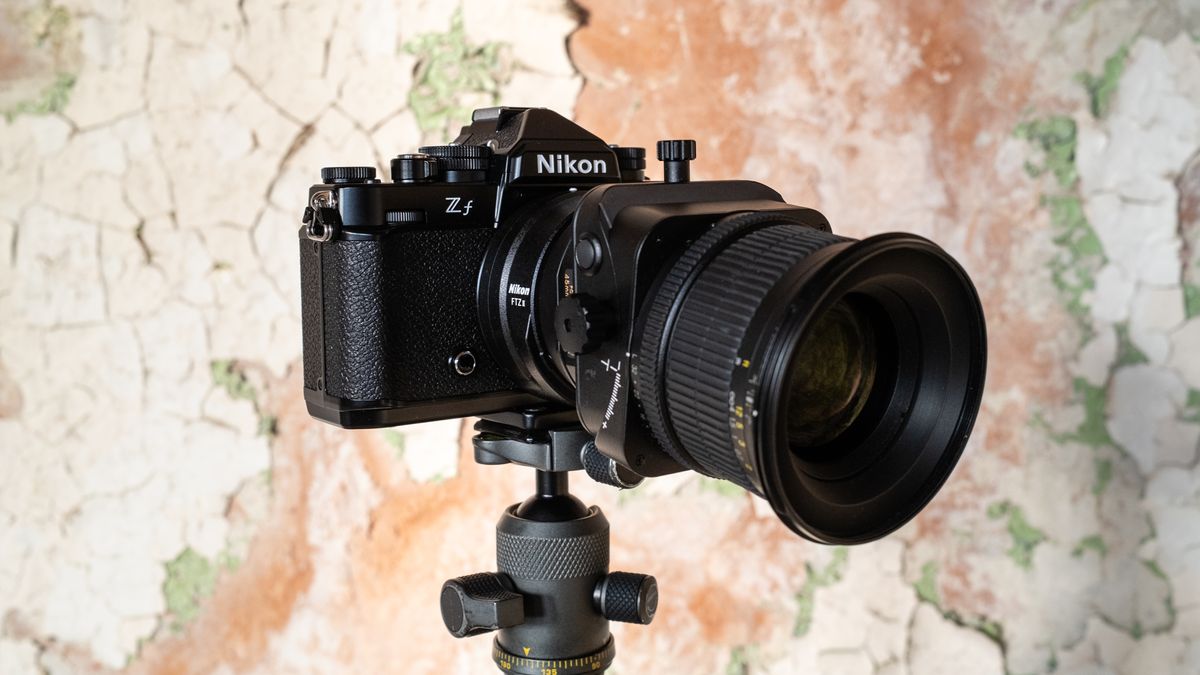
This amazing Nikon Zf feature changes manual focusing forever – and even works with vintage lenses
The Zf might just be the best mirrorless camera for manual focus
Another option is to switch on subject detection where there are Auto, People, Animal, Vehicle, and Airplanes to choose from. In this mode, which coincidentally also works with AF, the camera identifies the subject and will, for instance, put focus guides around the subject’s eyes when set to People, making it quick and easy to manually focus on the eyes when shooting at a wide aperture. With Animal, the camera will detect the closest part of the animal to the lens unless the eyes can be seen.
Another point that is worth knowing on the Z6. The little square that shows the focus point can move around on the screen to various points. You can program, in the menus, the button that controls this focus square to bring the square back to the center when the center of the button is pushed.
It took me a long time to figure out how to do this, but it made the close focus function markedly more useful.
This is accomplished as follows:
CUSTOM SETTINGS MENU
f Controls
2f Custom Control Assignment
[choose a button; I chose the 4-way controller center-press]
choose RESET Select center focus point
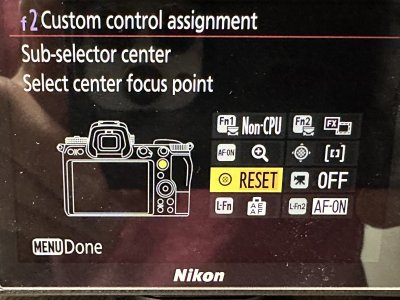
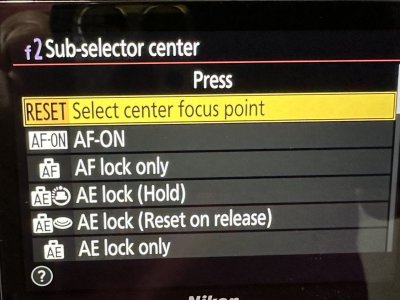
maryland_fotos
Well-known
@splitimageview Thanks for posting that screenshot, it looks like a good aid for manual focusing. I am going to give it a try today in the Zf.
Ergonomically this works for me, zoom assigned to AF-ON (default zoom can also vary in magnification) and re-center by pressing in on the four-way controller.
MarkWalberg
Established
I programed the zoom focus to the little button with the red dot next to the shutter release, which is the Movie Record button. I never make anything other than still pictures. The little button is very easy to use by feel, and the shutter release is right next door. I'm sure there are a lot of good ways to do this, but this works great for me.
Godfrey
somewhat colored
Just been thinking outside the box, as it were. Would a DSLR, such as a Nikon 810, make focussing easier. If it and similar models have the green focus assist light in the middle it could be beneficial.
Any thought based on experience?
Ta
I used various adapted lenses on my DSLRs before mirrorless/EVF bodies were available. It was always a fraught experience: the adapted lenses had no auto-aperture so you either have to focus through a dim viewfinder or focus at full aperture, then stop down to meter and frame. The various focusing aids are mostly useless when you're stopped down and not much more useful when wide open. I only did adaptation when I wanted to use a lens that wasn't available in the DSLR's native mount as a result, or that I couldn't afford to buy/wouldn't use enough to spend the money on/had the lens anyway from some other system.
Mirrorless changed all that. It became easy to use adapted lenses from many systems even with dumb adapters. That was the death knell of my DSLR days.
G
Ricoh
Well-known
Thanks, that’s buried the DSLR idea.
SWB
Member
It's all very well assigning a focus point to follow, but accurate focus with any manual lens on a mirrorless camera still requires the lens to be opened up to it's maximum aperture (as what happens automatically with a typical SLR camera) for the focus point and focus peaking to work perfectly. Anything other than 'wide open' means the focus point will be displaying the DOF of a smaller aperture and there is no way to guess exactly where accurate focus is within that DOF in the viewfinder. So to focus on something critical it can't be done at f/8 but needs to be done at maybe f/2 or the widest aperture.This is accomplished as follows:
CUSTOM SETTINGS MENU
f Controls
2f Custom Control Assignment
[choose a button; I chose the 4-way controller center-press]
choose RESET Select center focus point
View attachment 4834576View attachment 4834575
Godfrey
somewhat colored
I've found that with most lenses I can focus satisfactorily with a good EVF (and with magnification) with lens openings down to about f/4 to f/5.6. It is also true that with a good EVF camera, it's quite easy to spin the aperture to wide open, focus, and then stop down to taking aperture for metering and framing with little in way of losses since the EVF will amp up the image brightness such that it remains easy to see what you're doing. This is where adapted lenses fall down on DSLRs because the viewfinder becomes too dim for useful framing and the metering range is compromised with a stopped down lens.
With some fast lenses (f/1.2 to f/1.8), contrast and resolution wide open is poor enough that one stop down enables easier critical focusing than with the wide open setting. This is rare but I've seen it on occasion.
By and large, all things taken together, using the native mount lenses on ANY camera is easier and less prone to focusing or metering issues than using adapted lenses. But it is fun to experiment with alternatives, and with mirrorless/EVF cameras it can be a quite successful experience most of the time.
G
With some fast lenses (f/1.2 to f/1.8), contrast and resolution wide open is poor enough that one stop down enables easier critical focusing than with the wide open setting. This is rare but I've seen it on occasion.
By and large, all things taken together, using the native mount lenses on ANY camera is easier and less prone to focusing or metering issues than using adapted lenses. But it is fun to experiment with alternatives, and with mirrorless/EVF cameras it can be a quite successful experience most of the time.
G
Agree with @Godfrey.
Recently was using a 35/2.8 Distagon (Contax/Yashica mount) when shooting my 3 y.o. granddaughter -- constant motion. Chose a wide for a little extra DOF. Stopped the lens down in order to gain a bit of focus margin, and it worked well. EVF was plenty bright enough, even in room lighting. Cropped a bit.
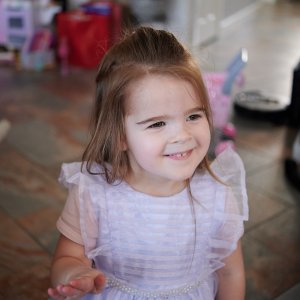
Recently was using a 35/2.8 Distagon (Contax/Yashica mount) when shooting my 3 y.o. granddaughter -- constant motion. Chose a wide for a little extra DOF. Stopped the lens down in order to gain a bit of focus margin, and it worked well. EVF was plenty bright enough, even in room lighting. Cropped a bit.

sojournerphoto
Mentor
All true in my experience. The ZM C-Sonnar is one of those lenses that is harder to focus wide open at f1.5 than at f2I've found that with most lenses I can focus satisfactorily with a good EVF (and with magnification) with lens openings down to about f/4 to f/5.6. It is also true that with a good EVF camera, it's quite easy to spin the aperture to wide open, focus, and then stop down to taking aperture for metering and framing with little in way of losses since the EVF will amp up the image brightness such that it remains easy to see what you're doing. This is where adapted lenses fall down on DSLRs because the viewfinder becomes too dim for useful framing and the metering range is compromised with a stopped down lens.
With some fast lenses (f/1.2 to f/1.8), contrast and resolution wide open is poor enough that one stop down enables easier critical focusing than with the wide open setting. This is rare but I've seen it on occasion.
By and large, all things taken together, using the native mount lenses on ANY camera is easier and less prone to focusing or metering issues than using adapted lenses. But it is fun to experiment with alternatives, and with mirrorless/EVF cameras it can be a quite successful experience most of the time.
G
Share:
-
This site uses cookies to help personalise content, tailor your experience and to keep you logged in if you register.
By continuing to use this site, you are consenting to our use of cookies.


